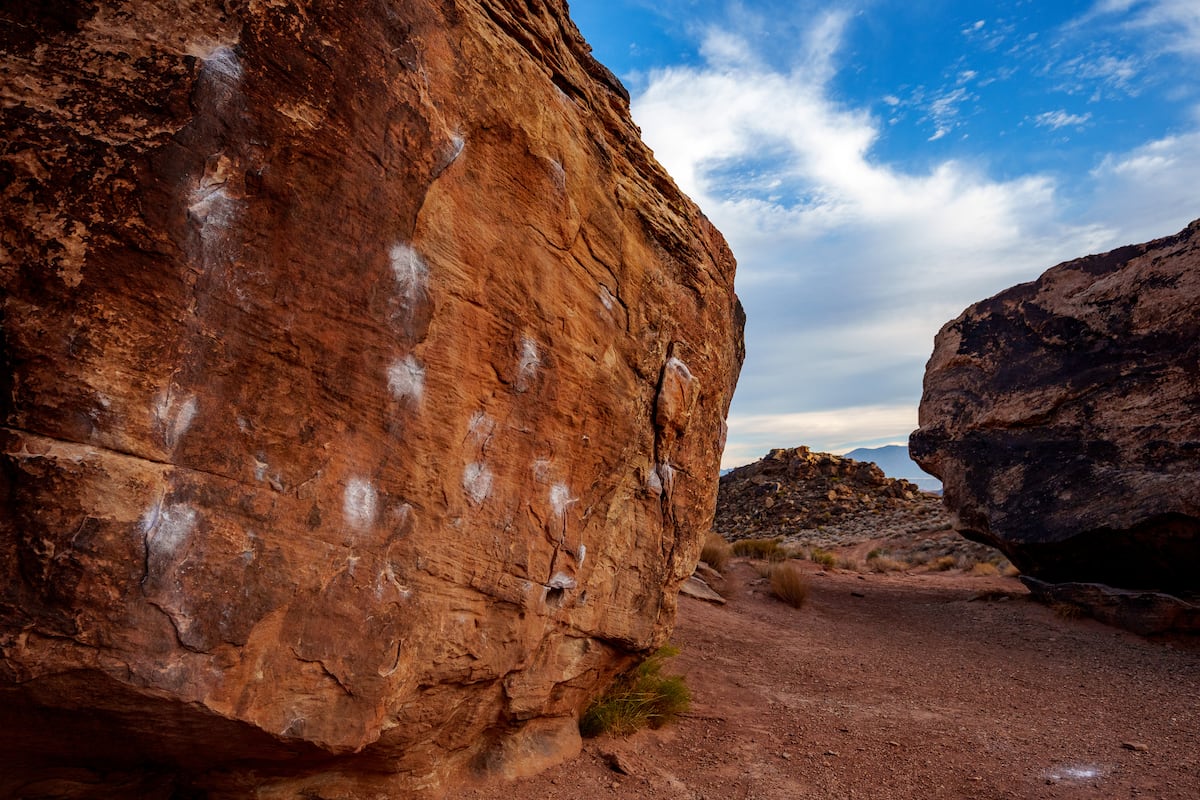Copyright Salt Lake Tribune

Supe Lillywhite got his first taste of bouldering as a teenager. The first challenge: Sentinel, an orange sandstone giant in Moe’s Valley. The roughly16-foot tall boulder is one he and his friends would continue to climb and camp under countless times over the years. “It was pretty awesome to be 16 years old and to be able to feel like you were out camping someplace cool,” he said. “But really you were only 15 minutes away from your parents’ house.” Camping in Moe’s Valley is illegal now, but Lillywhite still hopes his kids, ages five and two, can climb and bike in the area well into the future. That’s not guaranteed, though. In the two decades since Lillywhite first climbed Sentinel, housing developments in St. George have encroached around the edge of Moe’s Valley. The dirt roads that used to lead to the bouldering area are now paved over with modern homes and streets named “Top Rope Circle” and “Belayer Drive.” “That’s a little bit of a sore spot in the climbing community,” said Lillywhite, who now manages The Desert Rat, a local outdoor gear store. “It becomes even more ironic if they do take away all the climbing out here.” Developers may one day pave over the beloved bouldering area. The Trust Lands Administration, or TLA, owns the land and parts of surrounding popular recreation areas in the greater Moe’s Valley, such as the Bearclaw Poppy mountain biking trail and Green Valley Gap climbing wall. The state entity must manage its lands in the most “profitable manner possible” for public schools and other beneficiaries, according to state law. In some places, that looks like oil and gas rigs. In rapidly growing southwest Utah, that often means real estate development. The TLA has agreed to take development of the greater Moe’s Valley off the table, though, if the federal government approves the Northern Corridor — a proposed four-lane highway that would run through habitat for the threatened Mojave desert tortoise in the Red Cliffs National Conservation Area on the northern edge of St. George. The Bureau of Land Management and U.S. Fish and Wildlife Service have flip-flopped on the controversial road, green-lighting it in 2021 then canceling it in December of last year to avoid destroying or damaging tortoise habitat. Now, the saga continues as the Utah Department of Transportation found BLM’s alternative plan to expand the existing Red Hills Parkway has “substantial technical and economic challenges,” according to BLM. On Oct. 3, the agency announced its reviewing the highway yet again. County leaders and conservation groups have fought over the Northern Corridor for decades. Since the future of many locals’ favorite trails have been thrown into the mix, climbers, bikers and hikers have been put “smack dab in the middle,” Lillywhite said. Last month, Washington County posted a video on its official Facebook page that called the local environmental nonprofit Conserve Southwest Utah a “special interest group” whose “reckless actions are paving the way for massive development, hotels, homes and commercial buildings, right on top of the trails you love.” Conserve Southwest Utah isn’t advocating for development of the greater Moe’s Valley, though, and it doesn’t own the land. The nonprofit wants a solution that protects the popular recreation area and keeps a highway out of desert tortoise habitat. “The only real way to save both the [national conservation area] and Moe’s Valley is the political will to do so,” said Stacey Wittek, executive director of Conserve Southwest Utah. She said Washington County has used Moe’s Valley “as a lever” to get members of the community on their side. Outdoor recreationists like Lillywhite haven’t seen a practical solution from Conserve Southwest Utah to protect the climbing and mountain biking areas they love, though. “Everybody wants an easy solution to all these problems,” Lillywhite said. “If there were easy solutions, it would have happened by now. … We live in a complex political environment where compromises have to be made.” Creating “Zone 6″ County and state leaders have repeatedly tried to get a highway through the Red Cliffs north of St. George for decades. But Moe’s Valley wasn’t brought into the mix until about eight years ago. In 2017, former Washington County Commissioner Dean Cox assembled county, state and federal officials to come up with a new approach to the Northern Corridor. That included identifying land outside the conservation area that could be protected as a trade off to alleviate impacts on the tortoises. During a meeting in May of that year, representatives from both the BLM and TLA said they had lands they could make available, according to a recording shared with The Tribune. The former associate director of TLA said the entity had a lot of land in Washington County where they thought tortoises lived. The TLA also owned lands near the eastern edge of the proposed Northern Corridor, so they stood to economically benefit from the increased traffic the highway would bring. “When the Northern Corridor first became a thing, we had some really good properties on the I-15 corridor at mile post 13 that were zoned for commercial uses,” Aaron Langston, assistant managing director of TLA’s Washington County office, told The Tribune last month. “And we thought, hey, if the Northern Corridor goes in, that will actually bring a lot of traffic right to those parcels.” After that 2017 meeting, Cameron Rognan, administrator of the county’s Habitat Conservation Plan, prepared a study of potential mitigation areas, focusing on the greater Moe’s Valley area. He found that was going to be “a great opportunity,” he told The Tribune last month. The county’s survey data shows the area supports a “relatively high density” of tortoises, according to a 2024 BLM environmental review. It’s also home to the endangered dwarf bearpoppy, an herb with bright white flowers that only grows in southwest Utah. Eventually, county and state officials landed on a proposal to add the greater Moe’s Valley area to the Red Cliffs Desert Reserve — a larger protected area that includes the conservation area — if federal agencies approved their highway. They called it “Zone 6.” Washington County then added the idea to their 2020 Habitat Conservation Plan, a document it updates every 25 years that outlines the steps it will take to reduce harm to the desert tortoise. That created an opening to protect Moe’s Valley. How Moe’s Valley gained protection — and lost it In the final days of President Donald Trump’s first term in 2021, the federal government granted the Utah Department of Transportation the Northern Corridor right-of-way. The four-lane highway would be 4.5 miles long, running for roughly 1.9 miles in the conservation area between Green Spring Drive to the east and Red Hills Parkway to the west. This action sparked the protection of Zone 6, expanding the reserve by 6,813 acres. Over half of the new zone was BLM land, and a good chunk of that was already managed as an “Area of Critical Environmental Concern” to protect the dwarf bearpoppy. Zone 6 also included roughly 3,000 acres of state trust lands, with the ultimate plan for TLA to work with the Interior Department to exchange its acreage in the reserve for federal lands elsewhere. That process takes a long time. Most of TLA’s lands in the original reserve, which was established nearly thirty years ago, still haven’t been exchanged or purchased. “What’s the probability of adding another 3,000 acres in Zone 6 and getting exchanged out any time soon? We recognize probability is low,” Langston said. So, when the federal government revoked UDOT’s right-of-way through the national conservation area in December 2024, effectively removing Zone 6 from the reserve, half of the lands in the greater Moe’s Valley were still owned by TLA and now open for business. TLA made that known. In anticipation of a reversal on the Northern Corridor, Langston presented at the Washington County Habitat Conservation Advisory Committee in Sept. 2024. He outlined what development in Zone 6 could look like: multimillion dollar homes, a luxury resort like Amangari or affordable housing in the southern section where utilities exist and the soil “lends itself to mass grading,” according to the meeting minutes. Lillywhite and other leaders in the local outdoor rec community attended the meeting, listening as Langston described a future where mega-mansions cover their beloved bouldering fields and biking trails. Lillywhite said he was “pissed.” He wanted to save both the conservation area and the cherished recreation spot and was determined to find a way. He and his fellow climbers and bikers banded together. They started learning all they could about the land they loved, who controlled it and a lot of government acronyms. “All these terms that no normal person ever needs to know about, but suddenly it’s like you have to know about them or all this stuff goes away,” Lillywhite said. They pulled together a petition, which garnered over 17,000 signatures. They met with TLA and showed up at city council and county commission meetings. They also looked into what it may take to buy the land, but couldn’t find any individual or land trust with the millions of dollars needed. Then, on Oct. 3, BLM put the Northern Corridor and Zone 6 back on the table. An uncertain future Lillywhite said he didn’t want to tell people what to say to the BLM during its recent comment period on the Northern Corridor. “I definitely am not trying to tell anybody you should support the Northern Corridor,” he said. “I totally see both sides of this.” But at this point, he also doesn’t see any other practical way to protect Moe’s Valley. Fallon Rowe, vice president of the St. George Climbers Coalition, feels similarly. She’s a professional climber and geologist and used to have a sticker on her laptop that said “No Highway through Red Cliffs.” She even worked as a contractor for Conserve Southwest Utah on a different issue. “I used to be very on the same table as CSU, like, let’s fight to get the highway off the table, let’s also try to protect Zone 6 through whatever means,” said Rowe, who has been organizing alongside Lillywhite for roughly a year. “But I have yet to see a pragmatic proposal of how we can have our cake and eat it too, like fight the Northern Corridor and protect Zone 6. No one has been able to produce a legitimate plan,” she added. Wittek, director of Conserve Southwest Utah, said a solution will be found through grassroots advocacy and coalition building. She told The Tribune she thought a land exchange could still be possible, whether that’s a purchase by a land trust or exchange with the federal government. “We have to see it as a solvable problem,” she said. She did not provide any specific plans, though. Washington County Commissioner Adam Snow insists the Northern Corridor deal is “the only plausible way” to protect the tortoise, recreation and meet the county’s transportation needs. “If you really care about the tortoise, you care about protecting Zone 6,” he said. “If you care about recreation, you care about protecting Zone 6.” Regardless of the outcome, the fight for greater Moe’s Valley and other hiking, biking and climbing areas around St. George is far from over. Recreationists are already seeing development encroach further. Construction began on the new Divario housing development two months ago at the base of the Zen Trail, right on the outskirts of the Zone 6 boundary, raising alarms among Lillywhite and his fellow bikers and climbers. They met with the city and developer and learned with relief that Divario has an agreement with the city to maintain access to the trail and set aside land for open space. TLA may make similar arrangements. Earlier this year it received one “very viable offer” to develop affordable housing in the southeast part of Zone 6. That developer proposed enhancing the popular Bearclaw Poppy trail and keeping it open to the public. Langston said the proposal is on hold as the BLM reconsiders the Northern Corridor proposal. Meanwhile, Lillywhite and others are mapping trails and boulders to see if TLA will consider conservation easements on just those pieces of land. They’re also focusing on their local government. Two months ago, they asked the St. George City Council to create an “Open Space and Recreation Preservation Committee” where recreationists could advise the city on proposed developments. “There’s other areas that 20 years in the future we’re going to be wishing that we’d done the work to save,” Lillywhite said. “But the time to start that is right now.”



